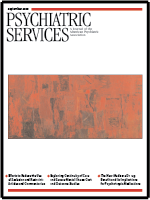Special Section on Seclusion and Restraint: Consumers' Perceptions of Negative Experiences and "Sanctuary Harm" in Psychiatric Settings
Abstract
OBJECTIVE: Recent studies show a high prevalence of trauma symptoms among people with serious mental illness who are treated in public-sector mental health systems. Unfortunately, growing evidence suggests that many consumers have had traumatic or harmful experiences while being treated in various psychiatric settings. This study explores consumers' perceptions of such harmful inpatient experiences, events that the authors place under the rubric of "sanctuary harm." METHODS: The authors conducted semistructured qualitative interviews with 27 randomly selected mental health consumers to hear their descriptions of adverse events that they experienced while receiving psychiatric care. Our analysis of interview transcriptions focused on understanding consumers' narratives of harmful experiences—events that would not meet DSM-IV criteria for trauma but that nevertheless resulted in significant distress. RESULTS: Eighteen of 27 interviewees described harmful incidents that they had witnessed or experienced directly, many of which evoked strong emotional responses by consumers during their narration. Nearly all incidents described were hospital based and were clustered around two sets of themes. The first set related to the hospital setting, including the fear of physical violence and the arbitrary nature of the rules. The second set related to the narrators' interactions with clinical staff, including depersonalization, lack of fairness, and disrespect. CONCLUSIONS: The findings suggest that many mental health consumers have had a lifetime sanctuary experience that they perceived as harmful. They also offered suggestions for how the mental health service delivery system might reduce the potential for sanctuary harm experiences.



